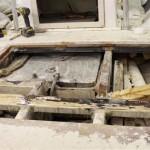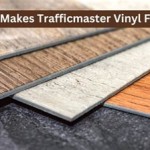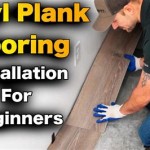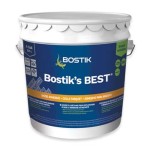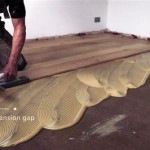Stick Down Laminate Flooring: A Comprehensive Guide
Stick down laminate flooring, also known as glue-down laminate, presents a unique and practical alternative to traditional click-lock laminate options. Its method of installation, directly adhering the laminate planks to the subfloor, offers distinct advantages in terms of stability, sound reduction, and design flexibility. This article provides a detailed examination of stick down laminate flooring, covering its characteristics, benefits, installation procedures, maintenance requirements, and considerations for selecting the optimal type for specific applications.
Unlike floating laminate floors, which interlock and rest on a subfloor with an underlayment, stick down laminate relies on a strong adhesive bond. This direct adhesion creates a more integrated flooring system, minimizing movement and contributing to a quieter and more solid feel underfoot. Understanding the nuances of this flooring type is crucial for making informed decisions about its suitability for various projects.
Key Advantages of Stick Down Laminate
Stick down laminate flooring offers several compelling advantages over its floating counterparts, making it a preferred choice for specific installations. These benefits span across durability, aesthetic potential, and overall performance.
Superior Stability and Durability: The direct adhesion to the subfloor provides exceptional stability, preventing shifting and minimizing the potential for separation between planks. This is particularly beneficial in high-traffic areas or spaces subject to temperature fluctuations. The robust bond also contributes to the overall durability of the floor, making it resistant to dents, scratches, and wear.
Enhanced Sound Reduction: By eliminating the air gap typical of floating floors, stick down laminate significantly reduces impact noise and sound transmission. The adhesive layer acts as a sound dampener, creating a quieter and more comfortable environment. This is especially important in multi-story buildings or areas where noise control is a priority.
Design Versatility: Stick down laminate offers greater flexibility in design layouts. It allows for intricate patterns, borders, and inlays that are often difficult or impossible to achieve with floating floors. This is due to the ability to precisely position and secure each plank, enabling customized and visually appealing installations.
Moisture Resistance Considerations: While not inherently waterproof, stick down laminate, when properly installed with a suitable adhesive and sealed seams, can offer improved moisture resistance compared to some floating options. The direct bond prevents water from easily seeping beneath the flooring, minimizing the risk of damage to the subfloor. However, it’s essential to address any existing moisture issues in the subfloor prior to installation.
Reduced Floor Height: Because stick down laminate doesn't require an underlayment (in most cases, unless a specific underlayment is desired for additional sound dampening or subfloor imperfections), the overall floor height is often lower than with floating options. This can be advantageous in situations where maintaining existing floor levels is crucial, such as matching the height of adjacent flooring materials.
Installation Process: A Step-by-Step Guide
The successful installation of stick down laminate flooring hinges on meticulous preparation and adherence to proper techniques. A thorough understanding of the installation process is essential for achieving a professional and long-lasting result.
Subfloor Preparation: The subfloor must be clean, dry, level, and structurally sound. Any imperfections, such as cracks, holes, or unevenness, should be addressed before proceeding. This may involve patching, leveling compounds, or even subfloor replacement in severe cases. The subfloor should be free of dust, debris, paint, wax, grease, and any other contaminants that could compromise the adhesive bond. Moisture testing is crucial to ensure the subfloor meets the manufacturer's recommended moisture content levels. Failure to properly prepare the subfloor is a primary cause of installation failures.
Acclimation: Like all laminate flooring, stick down laminate requires acclimation to the room's temperature and humidity for a specified period, typically 48 to 72 hours. This allows the laminate to expand or contract, minimizing dimensional changes after installation. Follow the manufacturer's instructions for acclimation procedures, as they may vary depending on the product.
Layout Planning: Before applying adhesive, plan the layout of the flooring to minimize waste and ensure a visually appealing pattern. Consider the direction of the planks, the placement of seams, and the location of any borders or inlays. Dry-laying the first few rows is highly recommended to check the alignment and spacing.
Adhesive Application: Use a high-quality adhesive specifically designed for laminate flooring. Apply the adhesive evenly and according to the manufacturer's instructions, using the recommended trowel size. Work in manageable sections to prevent the adhesive from drying before the planks are installed. Avoid applying excessive adhesive, which can squeeze up between the planks and create a mess.
Plank Placement: Carefully position each plank into the adhesive, ensuring proper alignment and tight seams. Press the plank firmly into the adhesive to ensure a strong bond. Use a roller or weighted tool to further secure the plank and remove any air pockets. Clean any adhesive residue from the surface of the planks immediately with a damp cloth.
Cutting and Fitting: Accurate cutting and fitting are essential for achieving a professional-looking installation, especially around walls, doorways, and other obstacles. Use a sharp utility knife or a laminate cutter to make precise cuts. Leave a small expansion gap around the perimeter of the room to allow for seasonal movement.
Sealing and Finishing: After the adhesive has fully cured, apply a sealant to the seams to prevent moisture penetration. Use a sealant specifically designed for laminate flooring and follow the manufacturer's instructions for application. Install baseboards or quarter-round molding to cover the expansion gap and provide a finished look.
Maintenance and Care
Maintaining stick down laminate flooring is generally straightforward, but it’s essential to implement proper cleaning and care practices to preserve its appearance and prolong its lifespan.
Regular Cleaning: Sweep, dust mop, or vacuum the floor regularly to remove dirt, dust, and debris. Use a vacuum with a soft brush attachment to prevent scratching the surface. Avoid using abrasive cleaners, scouring pads, or steel wool, as these can damage the laminate finish.
Damp Mopping: Damp mop the floor as needed using a mild cleaner specifically designed for laminate flooring. Avoid using excessive water, as this can seep into the seams and damage the subfloor. Wring out the mop thoroughly before applying it to the floor. Dry the floor immediately after mopping to prevent water spots.
Spill Management: Clean up spills immediately to prevent staining or damage to the laminate. Use a clean cloth or paper towel to blot the spill, working from the outside inward. Avoid rubbing the spill, as this can spread it further.
Protection from Scratches and Dents: Place mats at entrances to trap dirt and debris. Use furniture pads under the legs of chairs, tables, and other furniture to prevent scratches and dents. Avoid wearing shoes with high heels or cleats on the flooring.
Avoiding Excessive Moisture: While stick down laminate offers improved moisture resistance, it's still important to avoid excessive moisture exposure. Address any leaks or spills promptly. Avoid using steam mops or other cleaning methods that introduce large amounts of water to the floor. In areas prone to moisture, such as bathrooms or kitchens, consider using a more water-resistant flooring option.
Professional Cleaning: For more extensive cleaning or stain removal, consider hiring a professional floor cleaning service that specializes in laminate flooring. They have the equipment and expertise to safely and effectively clean and restore the flooring.
Repairing Damaged Planks: In the event of damage to a plank, such as a deep scratch or dent, it may be possible to repair or replace the individual plank. Consult with a flooring professional for recommendations on repair methods or replacement options. It is often advisable to keep extra planks from the original installation for such repairs.
By following these maintenance and care guidelines, you can ensure that your stick down laminate flooring remains beautiful and durable for years to come. Proper care not only enhances the appearance of the floor but also contributes to its overall longevity.

Laminate Flooring Or Glued Which Is Best

Pros Cons Of Glue Down Flooring Installation Floorset

Glue Down Vs Floating Lvp Which Is Better Whole Cabinet Supply

Does Vinyl Flooring Need To Be Glued Down Thediyplan

7 Things To Know About L And Stick Flooring

Can I Install Vinyl Tiles Over Laminate Flooring Comprehensive Guide

L And Stick Vinyl Plank Flooring 101 Floorings

Laminate Flooring Or Glued Which Is Best

Luxury Vinyl Flooring Vs Glue Direct Wood

How To Install L And Stick Vinyl Flooring Over Existing
Related Posts

